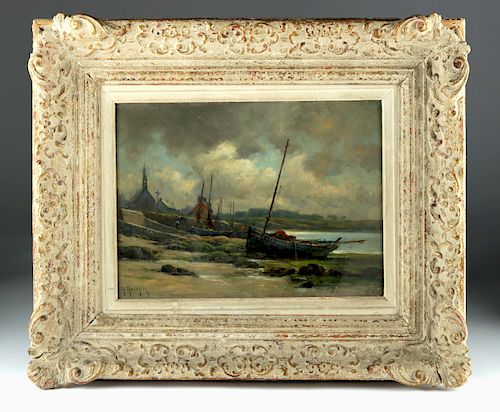Late 19th C. G. Marioniez Oil Painting of Port Scene
Lot 110m
About Seller
Artemis Fine Arts
686 S Taylor Ave, Ste 106
Louisville, CO 80027
United States
Selling antiquities, ancient and ethnographic art online since 1993, Artemis Gallery specializes in Classical Antiquities (Egyptian, Greek, Roman, Near Eastern), Asian, Pre-Columbian, African / Tribal / Oceanographic art. Our extensive inventory includes pottery, stone, metal, wood, glass and textil...Read more
Categories
Estimate:
$2,500 - $5,000
Absentee vs Live bid
Two ways to bid:
- Leave a max absentee bid and the platform will bid on your behalf up to your maximum bid during the live auction.
- Bid live during the auction and your bids will be submitted real-time to the auctioneer.
Bid Increments
| Price | Bid Increment |
|---|---|
| $0 | $25 |
| $300 | $50 |
| $1,000 | $100 |
| $2,000 | $250 |
| $5,000 | $500 |
| $10,000 | $1,000 |
| $20,000 | $2,500 |
| $50,000 | $5,000 |
| $100,000 | $10,000 |
| $200,000 | $20,000 |
About Auction
By Artemis Fine Arts
Jun 20, 2018
Set Reminder
2018-06-20 10:00:00
2018-06-20 10:00:00
America/New_York
Bidsquare
Bidsquare : DAY 1 | Antiquities, Asian, Russian, Fine Art
https://www.bidsquare.com/auctions/artemis-gallery/day-1-antiquities-asian-russian-fine-art-3276
Day 1 of an important 2-day auction featuring exceptional art from around the world Artemis Fine Arts info@artemisgallery.com
Day 1 of an important 2-day auction featuring exceptional art from around the world Artemis Fine Arts info@artemisgallery.com
- Lot Description
Georges Philibert Charles Marioniez (French, 1865-1933), port scene, oil on board, ca. late 19th C. to turn-of-the-20th century CE, signed G. Marioniez on lower left. This enchanting oil painting by Maroniez depicts a port scene at twilight, with natural light shining through the clouds and backlighting the sailboats, water, coastline, churches, and vernacular buildings - casting a luminous glow, with light radiating through the ominous clouds above. Throughout his career, Marioniez painted genre scenes of peasants, landscapes, scenes inspired by fishermens’ lives, as well as port scenes of Brittany, France, Belgium and the Netherlands. Many of Marioniez' paintings are housed in museums in the North of France, particularly in Douai and Cambrai. Size: 13.5" W x 9.75" H (34.3 cm x 24.8 cm); 21.375" W x 18" H (54.3 cm x 45.7 cm) framed
The son of an industrialist who owned a sugar refinery in Montigny-en-Ostrevent, France, Georges Philibert Marioniez was expected to pursue a serious profession rather than fine art - despite his artistic talent. Thus, he studied law and served as a magistrate in Boulogne-sur-Mer (1891), Avesnes-sur-Helpe (1894), and Cambrai (1897). However, while attending law school, Marioniez took art classes at the Ecole des Beaux-Arts of Douai and studied under Pierre Billet in Cantin. It was there that he met the artist Adrien Demont, who was the son-in law of the famous painter Jules Breton. Encouraged by Breton, he began exhibiting peasant genre and landscape scenes in Douai and Paris at the age of 22. Marioniez also began vacationing in Wissant, where he stayed with his Adrien Demont and his wife, Virginie Demont-Breton. There he devoted himself to painting coastal scenery and became associated with the "Ecole de Wissant", founded by Henri and Marie Duhem. In 1889, Marioniez became a member of the Societe des Artistes Francais. Marioniez' paintings of nature and the land, reflected his appreciation of the beauty of light, oftentimes capturing twilight in his paintings of the sea and ports which are always backlit like this example.
Marionez also grew interested in photography and actually invented one of the first hand-held cameras, named the "Sphynx" which he had patented in 1891. The camera used a type of film that was invented by industrialist Victor Planchon (1863-1935), who was his relative. Using his camera to take more than 1,600 images (currently in the collection of the museum in Cambrai). Marioniez travelled throughout the Mediterranean, the Middle East, and North Africa. Years later he also invented and patented a method of quelling the vibrations and jerky motions produced by the Lumiere Brothers' cinematographs. This device was unveiled in 1899 at the Societe Photographique in Cambrai. By 1905, Marioniez' success as an artist in combination with anti-clerical attitudes of the Combes administration led him to resign from the judiciary, and dedicate himself wholeheartedly to the pursuit of his art.
Marionez' "Paysage enneige au ruisseau" sold at J.P. Osenat Fontainebleau S.A.S (April 8, 2018 -Lot 11 - p. 7 of the catalogue) for $3,436 (2,800 Euros).
Marioniez' "Soleil Couchant" sold at Bonhams UK (March 22, 2016 - Lot 133 - p. 70 of the catalogue) for $6,488.
Provenance: private Lucille Lucas collection, Crested Butte, Colorado, USA
All items legal to buy/sell under U.S. Statute covering cultural patrimony Code 2600, CHAPTER 14, and are guaranteed to be as described or your money back.
A Certificate of Authenticity will accompany all winning bids.
We ship worldwide and handle all shipping in-house for your convenience.
#134049Painting is in excellent condition. Verso shows darkening and some stains that do not interfere with the imagery. Old note on verso states, "Cleaned" suggesting that the painting was cleaned at one time. Original antique frame (gilded and painted plaster covered wood) shows some fissures and losses, but could be restored. #8 handwritten in pencil on verso.Condition
- Shipping Info
-
All shipping is handled in-house for your convenience. Your invoice from Artemis Gallery will include shipping calculation instructions. If in doubt, please inquire BEFORE bidding for estimated shipping costs for individual items.
-
- Buyer's Premium



 EUR
EUR CAD
CAD AUD
AUD GBP
GBP MXN
MXN HKD
HKD CNY
CNY MYR
MYR SEK
SEK SGD
SGD CHF
CHF THB
THB















